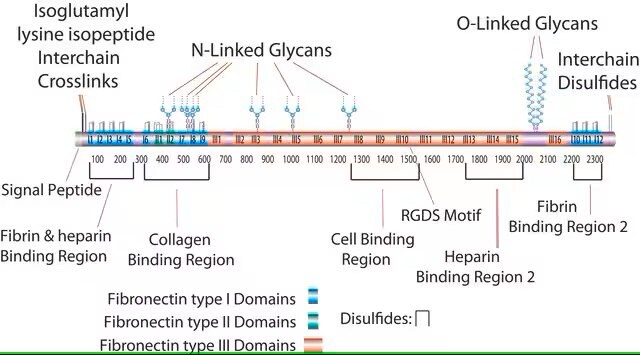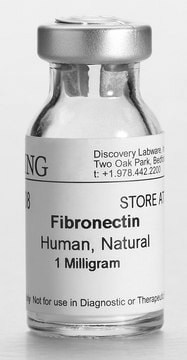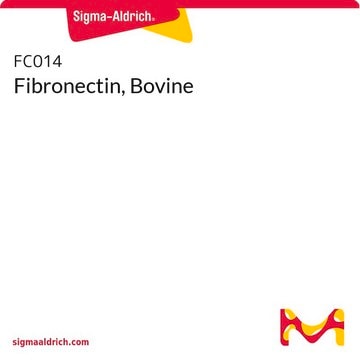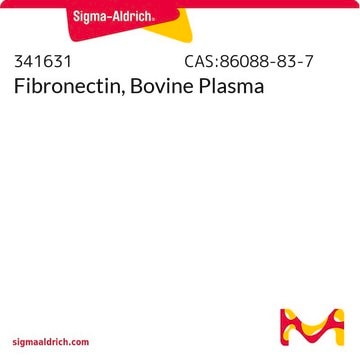Human fibronectin is composed of two nearly identical disulfide bound peptides. Each has a molecular weight of 220 kDa for a combined total of 440 kDa.
F1056
Human Fibronectin
from human plasma, powder, suitable for cell culture
Sinónimos:
Fibronectin
About This Item
Productos recomendados
Nombre del producto
Fibronectina, lyophilized powder, BioReagent, suitable for cell culture, ≥95% (SDS-PAGE)
origen biológico
human plasma
Nivel de calidad
esterilidad
sterile
Línea del producto
BioReagent
Ensayo
≥95% (SDS-PAGE)
Formulario
lyophilized powder
envase
pkg of 1 mg
pkg of 2 mg
pkg of 5 mg
técnicas
cell culture | mammalian: suitable
cobertura de la superficie
1‑5 μg/cm2
solubilidad
H2O: 1 mg/mL at 37 °C
Nº de acceso UniProt
Especificidad de unión
Peptide Source: Collagen
Condiciones de envío
dry ice
temp. de almacenamiento
−20°C
Información sobre el gen
human ... FN1(2335)
¿Está buscando productos similares? Visita Guía de comparación de productos
Descripción general
Aplicación
Acciones bioquímicas o fisiológicas
Precaución
Nota de preparación
In coating culture surfaces, fibronectin should be diluted in sterile balanced sterile salt solution and coated with minimal volume. Surface should then be air dried for 45 minutes at room temp and can be stored for 2-4 weeks at 2-8°C.
Cláusula de descargo de responsabilidad
Código de clase de almacenamiento
11 - Combustible Solids
Clase de riesgo para el agua (WGK)
WGK 3
Punto de inflamabilidad (°F)
Not applicable
Punto de inflamabilidad (°C)
Not applicable
Equipo de protección personal
Eyeshields, Gloves, type N95 (US)
Elija entre una de las versiones más recientes:
Certificados de análisis (COA)
¿No ve la versión correcta?
Si necesita una versión concreta, puede buscar un certificado específico por el número de lote.
¿Ya tiene este producto?
Encuentre la documentación para los productos que ha comprado recientemente en la Biblioteca de documentos.
Los clientes también vieron
Artículos
Extracellular matrix proteins such as laminin, collagen, and fibronectin can be used as cell attachment substrates in cell culture.
Extracellular matrix proteins such as laminin, collagen, and fibronectin can be used as cell attachment substrates in cell culture.
Extracellular matrix proteins such as laminin, collagen, and fibronectin can be used as cell attachment substrates in cell culture.
Extracellular matrix proteins such as laminin, collagen, and fibronectin can be used as cell attachment substrates in cell culture.
Protocolos
Dilute fibronectin for cell attachment, varying per cell type. Coating protocol, products, and FAQs provided.
Dilute fibronectin for cell attachment, varying per cell type. Coating protocol, products, and FAQs provided.
Dilute fibronectin for cell attachment, varying per cell type. Coating protocol, products, and FAQs provided.
Dilute fibronectin for cell attachment, varying per cell type. Coating protocol, products, and FAQs provided.
-
What is the molecular weight of this product?
1 answer-
Helpful?
-
-
This is to ask a question regarding coating flasks with the human freeze-dried fibronectin (F1056). After dissolving it in sterile water and diluting to the desired concentration should I incubate the flasks at 4 or 37 degrees overnight? Many thanks!
1 answer-
As noted in the DESCRIPTION section of the Product Detail Page, fibronectin should be diluted in a sterile balanced sterile salt solution and coated with minimal volume. The surface should then be air dried for 45 minutes at room temp and can be stored for 2-4 weeks at 2-8°C. See the information below for a brief protocol:
To coat culture surfaces:
1. Dilute fibronectin in a sterile balanced salt solution
and coat the culture surface (1-5 mg/cm2) with a
minimal volume.
2. Allow to air dry for at least 45 minutes at room
temperature, Excess fibronectin may be removed
by aspiration, but this is not necessary.
3. Fibronectin coated cultureware can be stored for
2-4 weeks at 2-8 °C in a closed sterile container or
sterile sealable bags.Helpful?
-
-
How do I solubilized Fibronectin?
1 answer-
Dissolve at 1 mg/mL in water. Allow to dissolve for at least 30 minutes at 37 °C. A small amount of undissolved material may remain. This will not affect product performance.
Helpful?
-
-
How do I choose which fibronectin product to use to coat culture surfaces for cell growth?
1 answer-
The species source for the fibronectin used when coating culture surfaces is not important. It is the presence of the RGD binding site that is present in all fibronectins that promotes binding.
Helpful?
-
-
How long can I store the fibronectin solution?
1 answer-
The product is good for at least a year at 2-8 °C if kept sterile.
Helpful?
-
-
What is the Department of Transportation shipping information for this product?
1 answer-
Transportation information can be found in Section 14 of the product's (M)SDS.To access the shipping information for this material, use the link on the product detail page for the product.
Helpful?
-
-
How do I determine how much fibronectin is in solution?
1 answer-
As the product may contain undissolved material, the amount of fibronectin in solution can be determined by UV absorbance. The extinction coefficient for a 1% solution (10 mg/ml) is 13.5 at 280 nm.
Helpful?
-
-
How do I test the wells/flasks that have been coated with fibronectin?
1 answer-
We test the coated culture surface by culturing cells. We compare the adherence of the cells to wells that have been coated with media containing BSA (negative) and media containing 10% FBS (positive). The cell growth should be not less than 50% of the positive control and greater than 50% of the negative control.
Helpful?
-
-
What is the difference between Fibronectin Products F2006 and F1056?
1 answer-
The difference between Product Nos. F2006 and F1056 is in the purity specifications and endotoxin testing. Product No. F2006 has a purity specification of ≥90% and is not tested for endotoxin contamination. Product No. F1056 has a purity specification of ≥95% and is tested for endotoxin contamination with a specification of ≤100 EU/mg.
Helpful?
-
-
What is the procedure for coating culture surfaces with fibronectin?
1 answer-
To coat culture surfaces: 1. Dilute fibronectin in sterile balanced salt solution and coat the culture surface (1-5 μg/cm2) with a minimal volume. 2. Allow to air dry for at least 45 minutes at room temperature. Excess fibronectin may be removed by aspiration, but this is not necessary.
Helpful?
-
Active Filters
Nuestro equipo de científicos tiene experiencia en todas las áreas de investigación: Ciencias de la vida, Ciencia de los materiales, Síntesis química, Cromatografía, Analítica y muchas otras.
Póngase en contacto con el Servicio técnico







